- Reference
- Fl.Austral. 6:425 (1873)
- Conservation Code
- Not threatened
- Naturalised Status
- Native to Western Australia
- Name Status
- Current
Shortly rhizomatous, perennial, grass-like or herb, 0.15-0.4 m high. Fl. white-cream-blue, Oct to Dec. White, grey-brown sand, gravel.

Scientific Description
Leaves round (leaves terete), 140-400 mm long, 0.5-1.5 mm wide; bristles or hairs on the leaf margin present, 0.6-4 mm long, with at least some small side branches at the base, straight and rigid or flexuose and soft, lying parallel with the margin or angled towards the leaf apex; hairs on the surface of the leaf absent (leaf surfaces glabrous). Scape present, glabrous, 105-640 mm long. Inflorescence subtended by a bract 10-15 mm long, with several flowers; floral bracts 1.5-1.7 mm long; pedicels present, 0.3-1 mm long; flowers 5-7.5 mm long. Perianth hairy, radially symmetrical, uniformly coloured, white to cream, with six more or less equal tepals, the inner segments 4.5-5.7 mm long. Stamens six, in one level; filaments 0-0.5 mm long; anther 1.7-2 mm long, without an appendage. Style 2.7-4.5 mm long. Flowers in October, November or December. Occurs in the Geraldton Sandplains, Swan Coastal Plain and Jarrah Forest IBRA bioregion(s), of the South-west Botanical Province.
Distribution
- IBRA Regions
- Geraldton Sandplains, Jarrah Forest, Swan Coastal Plain.
- IBRA Subregions
- Dandaragan Plateau, Lesueur Sandplain, Northern Jarrah Forest, Perth, Southern Jarrah Forest.
- IMCRA Regions
- Central West Coast.
- Local Government Areas (LGAs)
- Armadale, Augusta Margaret River, Belmont, Busselton, Capel, Cockburn, Coorow, Dandaragan, Gingin, Gosnells, Irwin, Kalamunda, Melville, Perth, Serpentine-Jarrahdale, Swan, Victoria Plains.